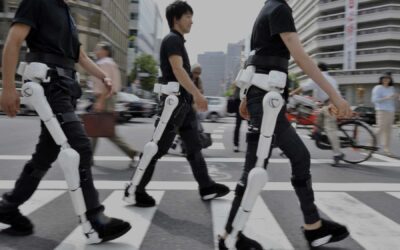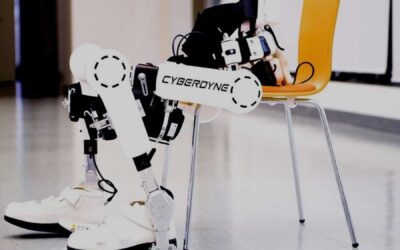Any movement in the body triggers bio-electrical signals from the brain that communicate with the muscles that make locomotion possible. Such signals from paralysed or disabled patients may be too weak to trigger proper movement.
Using the sensors attached to the skin’s surface, HAL detects these so-called “bio-electrical signals” to perform the desired movements with the wearer’s voluntary commands.
Neuromuscular feedback therapy leads to a significant gain in functional locomotion in patients with a stroke. Other effects of the “Wearable Cyborg™ HAL® which can be more or less pronounced include:
- Reducing neuropathic pains
- Improving bladder and bowel functions
The HAL® Principle in Cyberdyne Treatment

- Think-
During a person’s body movement, they first think about the motions in their brain. By thinking “I want to walk.”, the brain transmits necessary signals to muscles necessary for the motions through the nerves.
- Send Signals-
In a healthy body, each muscle can receive signals destined from the brain to it and move as strongly and fast as intended. However, in the case of – the Wearable Cyborg™ – HAL®, it is done with help of the technology involved in stimulating the nerves.
- Read the signals-
Signals sent to muscles by the brain leak on the skin surface as very faint signals, so-called “bio-electric signals [BES]”. HAL® can read BES by only attaching the originally developed detectors on the surface of the wearer’s skin. By consolidating various information HAL®, recognises what sorts of motions the wearer intends.
- Recognise the movements-
HAL, as well as man, is also able to process various information recognised by the brain instantly and control the power unit promptly. When the body starts moving, HAL starts moving at the same time. Therefore, HAL can assist the wearer’s s motions.
- Response-
The mechanism to move the human body does not end up with only moving muscles. The brain confirms how the body moves on what sort of signals. When HAL has appropriately assisted the motions of “walking”, the feeling “I could walk!” is fed back to the brain.

By this means, the brain gradually learns how to emit necessary signals for “walking”. This leads to “the important first step” in walking the physically challenged person without being assisted by HAL®.
HAL is the only robot that can provide appropriate solutions for the motions of the brain.
Rehabilitation from Stroke Disease
The key to promoting functional improvement through Cyberdyne Treatment is not just transmitting voluntary command signals from the human brain to the musculoskeletal system via the spinal cord and peripheral nerves, but more so on the return of feedback from the sensation of actual movement to the human brain.
The functional improvement/regeneration technology using HAL® is an innovative treatment technology that enables the improvement of human brain-nerve-musculoskeletal functions by activating the body’s self-healing ability that humans are naturally in possession of.
The most effective rehabilitation is specific to the skills the patient needs, and of sufficient intensity and duration to truly retrain the nerves and muscles involved.
So, connect with us today at https://rehabmodalities.com/ for a free demo of our spectacular journey with Cyberdyne HAL!



